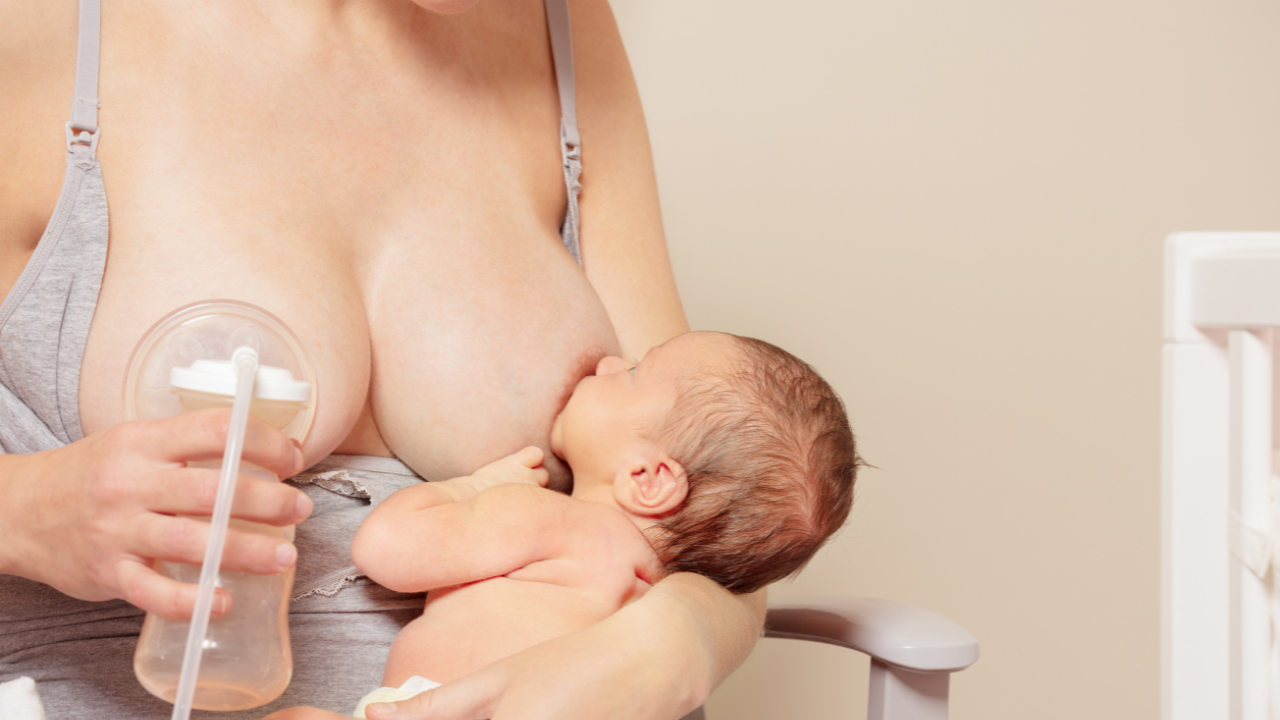If you’re not sure which breastfeeding positions are best, you’re not alone. Many new moms feel unsure or overwhelmed in the beginning. But finding the right position can make all the difference in comfort, bonding, and feeding success.
Breastfeeding is natural, but that doesn’t mean it always comes naturally. It may feel awkward at first, but both you and your baby are equipped with instincts and abilities to make it work. Billions of mothers have breastfed before you—you’ve got this.
Why Positioning Matters
A good position isn’t just about comfort—it’s key to a successful latch, (3) preventing soreness, and supporting your baby’s feeding. In fact, poor positioning is one of the top reasons moms stop breastfeeding early.
The right position can:
- Help your baby latch deeply and pain-free
- Prevent sore nipples (1) and engorgement
- Support healthy milk flow
- Reduce strain on your neck, back, and arms
- Make feeding feel more natural and less like a chore
Signs You’re in a Good Position
- Baby is tummy-to-tummy with you
- Their nose is free and their chin is touching your breast
- You hear soft swallowing
- You feel no pain, pulling, or pinching
- Your arms, back, and shoulders feel supported
Popular Breastfeeding Positions (and When to Use Them)
Laid-Back Breastfeeding Position


Also called biological nurturing, this is a great starting position, especially for newborns. You recline slightly, and your baby lies on your chest, tummy-down.
Why it works: Gravity helps with the latch, your baby’s natural instincts kick in, and your hands are free. This position supports skin-to-skin contact and helps you both relax.
Great for: Newborns, moms with strong let-down, skin-to-skin bonding
Bonus: It reduces nipple pain and helps baby self-latch.
The Cradle Hold Breastfeeding Position
A classic position where baby lies across your lap with their head in the crook of your arm.
Best for: Older babies with good head control
Tip: Use a pillow to bring baby to breast height and keep your shoulders relaxed.


Cross-Cradle Hold
Like cradle, but you support baby with the opposite arm to the breast you’re using. Your hand supports baby’s neck and shoulders.
Best for: Newborns still learning to latch
Why it helps: Gives you more control over your baby’s head and latch
Step-by-step:
- Use a pillow to support baby at breast height
- Hold baby tummy-to-tummy, with your palm supporting their head
- Use your other hand in a U-hold to shape your breast (fingers away from the areola)
- Tickle baby’s lips, wait for a wide open mouth, then bring them to you
Football Hold (Clutch Hold)
Baby is tucked under your arm on the side you’re feeding from, like holding a football.
Great for: Moms with large breasts, post-C-section recovery, twins, or a fast let-down
Step-by-step:
- Use a pillow to support baby along your side
- Hold baby’s head with your hand, neck supported by your fingers
- Baby’s body should be snug against your side
- Use your free hand to guide the breast

Side-Lying Breastfeeding Position
You and baby lie on your sides, facing each other.
Perfect for: Nighttime feeds, C-section recovery (2), rest during nursing
Tip: Use pillows behind your back and between your knees. Place a rolled blanket behind your baby to keep them from rolling away.
Bonus: Once latched, you can relax and even drift off.


Saddle Hold (Australian Hold)
Your baby sits facing you, legs astride your thigh or lap.
Best for: Toddlers, babies with colds or earaches
Why it works: It keeps baby upright and is great for nose or ear relief

Breastfeeding Twins
Try double football holds (one baby under each arm) or laid-back tandem nursing.
Tip: Use multiple pillows or a twin nursing pillow for support
Real talk: It takes practice, but you and your babies will find your groove


Breastfeeding Position Comfort Tips
- Always bring baby to the breast, not the other way around
- Use a nursing pillow or footrest for support
- Switch arms or positions if you feel fatigued
- Skin-to-skin contact helps regulate baby’s temperature and encourages feeding
- Don’t hesitate to ask for help—lactation consultants are superheroes
Final Thoughts
There’s no perfect position—only the one that works for you and your baby. Your comfort, your baby’s latch, and the feeding rhythm are what matter most.
So take a breath. Try different positions. Watch your baby’s cues. Ask for help when you need it. You and your baby are learning this together.
And remember: you were made for this.
Resources
- Find a breastfeeding support group near you.
- Milkology Breastfeeding Class – Affordable, video-based online course to help you master breastfeeding at your own pace.
References
- La Leche League International – Positioning and Latch
Trusted breastfeeding organization offering insight into biological nurturing and laid-back positions. - UNICEF Parenting – Breastfeeding Positions – Offers guidance for global audiences, including tips for laid-back breastfeeding and positioning.
- International Breastfeeding Journal – Laid-Back Breastfeeding Study – Study on how biological nurturing reduces early breastfeeding problems.
- PMC/National Library of Medicine – Positioning and Nipple Pain – Highlights how poor latch/positioning correlates with nipple trauma. (link 1)
- Thieme Medical Publishers – Breastfeeding Post C-section Study – Side-lying position found to improve maternal comfort after C-section. (link 2)
- NHS – Positioning and Attachment – UK health guidance for breastfeeding posture and latch cues. (link 3)


